Proper
Sealing of Outdoor Coax Connectors [or Waveguide Splice]
Everyone
seems to have a different idea how to properly seal outdoor coax
connectors, such as where the antenna cable connects to the rigid Heliax
feedline, or short jumper cable. The fact is over time, most cables actually allow small
amounts of air and moisture to pass through the jacket and find its
way inside your connectors. This moist air is not a problem until a
rapid temperature shift occurs and condensation forms inside a
connector, typically every evening. Since most commercial installations use type-N connectors,
it takes only 1 drop to alter the SWR and began to reduce the overall
antenna performance. For example, even with just 1 layer of a good
moisture-proof vinyl tape such as Scotch 33, over a connector on a
VHF antenna, within a year there will be at least 3 drops of water
inside the connector. This will reduce the antenna performance by at
least 65% and usually much worse. Therefore, the objective is twofold - seal the connector
from weather and provide thermal resistance to prevent condensation
for occurring inside the connector. Below are several well proven ways to provide excellent
protection from the problem above.
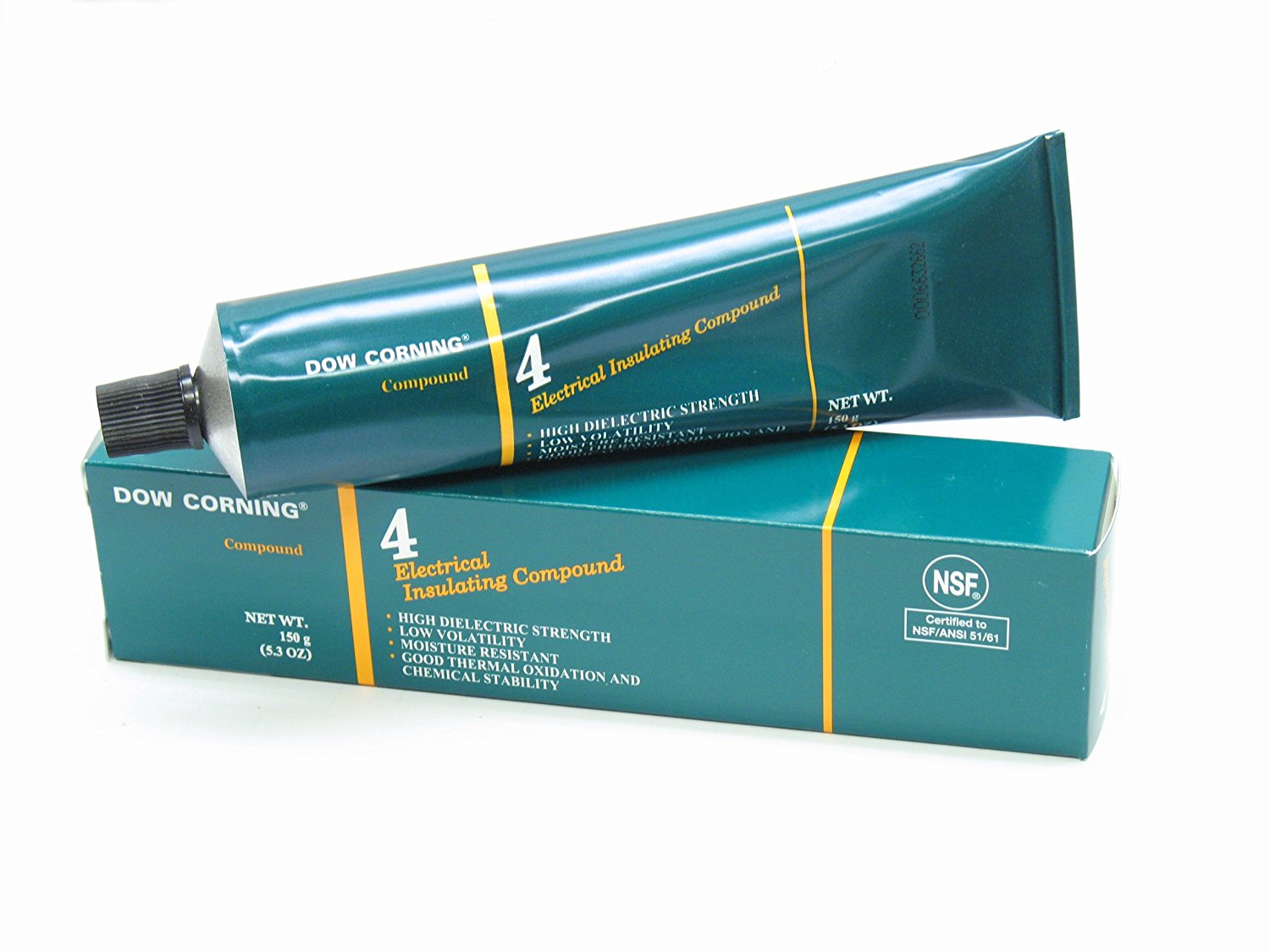 Packing
with silicon gel or grease - This concept we learned from the Air Force. It
seems that whenever an airplane takes off & reaches altitude, and then
eventually lands, the temperature of some of the electrical &
electronics equipment [outside the passenger area] can vary more than 50
degrees F, and sometimes over 100 degrees. This thermal shock with moist outside air cause small amounts of
condensation in electrical connectors, which leads to erratic performance of fire control RADAR
and other Radio equipment. It had long been standard practice to fill
the AN style electrical connectors with silicone grease, to prevent
arcing between pins from moisture. So it also became a standard practice to pack the inside of all
type-N coax connectors with silicone gel. It has been my experience
this works very well, but is very messy to work with, in particular
at the top of a tower. Andrew
has long supplied a tiny unmarked tube of this with each Heliax
connector to weatherproof the inside of the front and rear of each
connector. If the silicon grease gets on the outside of
the cable or connectors, due to mis-handling, vinyl tape will not stick.
However, if you are assembling things on the ground, and you have
clean rags and solvent to cleanup with, go for it. This product is sold as Dow Corning 4 Electrical Insulating Compound and is widely available from $12 to $18 per 5.3 Oz. tube. I buy from Skygeek.com
for under $15 per tube. One tube will last for many years if used just
for coax connectors. You may also find new military surplus tubes that
are out-of-date, but will work just fine. Be sure to wrap the outside of
the connectors with at least two layers of Scotch 33 [and 2242] tape when complete. Be advised, this is not
the same product as silicon sealant, this is a gel that remains a gel
and does not become solid. Do not use silicone sealant inside a
connector.
Packing
with silicon gel or grease - This concept we learned from the Air Force. It
seems that whenever an airplane takes off & reaches altitude, and then
eventually lands, the temperature of some of the electrical &
electronics equipment [outside the passenger area] can vary more than 50
degrees F, and sometimes over 100 degrees. This thermal shock with moist outside air cause small amounts of
condensation in electrical connectors, which leads to erratic performance of fire control RADAR
and other Radio equipment. It had long been standard practice to fill
the AN style electrical connectors with silicone grease, to prevent
arcing between pins from moisture. So it also became a standard practice to pack the inside of all
type-N coax connectors with silicone gel. It has been my experience
this works very well, but is very messy to work with, in particular
at the top of a tower. Andrew
has long supplied a tiny unmarked tube of this with each Heliax
connector to weatherproof the inside of the front and rear of each
connector. If the silicon grease gets on the outside of
the cable or connectors, due to mis-handling, vinyl tape will not stick.
However, if you are assembling things on the ground, and you have
clean rags and solvent to cleanup with, go for it. This product is sold as Dow Corning 4 Electrical Insulating Compound and is widely available from $12 to $18 per 5.3 Oz. tube. I buy from Skygeek.com
for under $15 per tube. One tube will last for many years if used just
for coax connectors. You may also find new military surplus tubes that
are out-of-date, but will work just fine. Be sure to wrap the outside of
the connectors with at least two layers of Scotch 33 [and 2242] tape when complete. Be advised, this is not
the same product as silicon sealant, this is a gel that remains a gel
and does not become solid. Do not use silicone sealant inside a
connector.
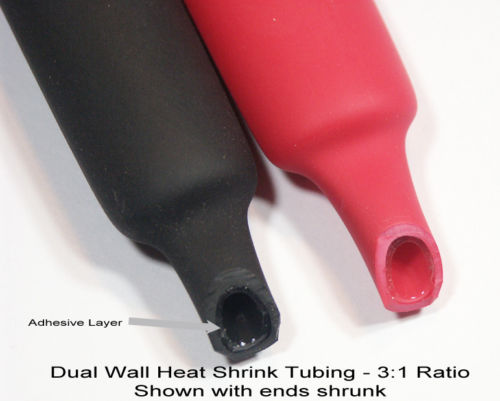 Glue
filled heat-shrink tubing
- This concept came from the cable TV
industry. These guys also use silicon grease in some aspects of their
network, but to get a water-tight seal in underground connectors,
they use a heat-shrink tubing, with a heat-activated glue inside. it
is best to place a single wrap of vinyl tape over the connectors
before placing the tubing in place, otherwise you will have a sticky
glue mess on the connectors. Then proceed to heat the tubing with
a propane torch, evenly all around. The
tubing should extend beyond the connectors at least 2 inches, so
there is a cable jacket to cable jacket bond. To remove, simply cut the
plastic end to end and peel. This product works great, but
using a propane torch at the top of a tower is sometimes a problem, and
it
sometimes drips hot glue on the workers below. Again, this is great on
the ground, but tricky
in the air. This product is widely available for around $10 per 1 inch
x 48 inch lengths. Be advised some glues may crystallize from sun &
weather, therefore radio manufacturers like Codan recommend placing a single wrap of self-amalgamating rubber tape over the tubing.
Glue
filled heat-shrink tubing
- This concept came from the cable TV
industry. These guys also use silicon grease in some aspects of their
network, but to get a water-tight seal in underground connectors,
they use a heat-shrink tubing, with a heat-activated glue inside. it
is best to place a single wrap of vinyl tape over the connectors
before placing the tubing in place, otherwise you will have a sticky
glue mess on the connectors. Then proceed to heat the tubing with
a propane torch, evenly all around. The
tubing should extend beyond the connectors at least 2 inches, so
there is a cable jacket to cable jacket bond. To remove, simply cut the
plastic end to end and peel. This product works great, but
using a propane torch at the top of a tower is sometimes a problem, and
it
sometimes drips hot glue on the workers below. Again, this is great on
the ground, but tricky
in the air. This product is widely available for around $10 per 1 inch
x 48 inch lengths. Be advised some glues may crystallize from sun &
weather, therefore radio manufacturers like Codan recommend placing a single wrap of self-amalgamating rubber tape over the tubing.
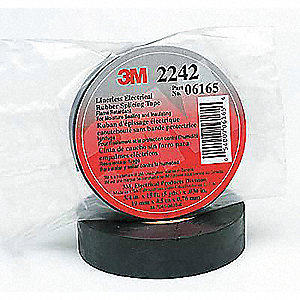 Wrap
with real rubber tape - This is my preference when working on top of a tower,
or otherwise. It is the cleanest to use and does not rely on torches
or solvents to do a clean job. Scotch 130C can be used in place of
Scotch 2242, but is more
expensive. The price ranges from $6 to $12 per roll of 3/4 inch x 15
ft. The tape is 0.030 [1/32] inches thick and easily stretches, but do
not over stretch it. It is self-amalgamating, so it cannot be unpeeled
after a few days. Do not
apply the rubber tape directly to the connectors, as it bonds to itself
and will not peel off after a few days. To remove, it must be cut off
and will leave a black sticky mess on the connectors unless a single
wrap of vinyl tape is used first.
Wrap
with real rubber tape - This is my preference when working on top of a tower,
or otherwise. It is the cleanest to use and does not rely on torches
or solvents to do a clean job. Scotch 130C can be used in place of
Scotch 2242, but is more
expensive. The price ranges from $6 to $12 per roll of 3/4 inch x 15
ft. The tape is 0.030 [1/32] inches thick and easily stretches, but do
not over stretch it. It is self-amalgamating, so it cannot be unpeeled
after a few days. Do not
apply the rubber tape directly to the connectors, as it bonds to itself
and will not peel off after a few days. To remove, it must be cut off
and will leave a black sticky mess on the connectors unless a single
wrap of vinyl tape is used first.
Be sure to stretch the tape as you
apply it. Fresh tape [within a year] works better than old tape.
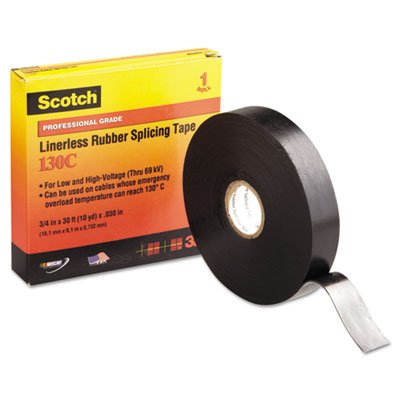 -
layer 1 is a thin vinyl tape which should be 15% overwrap and is to
protect the finish of the connectors, use Scotch 33 ;
-
layer 1 is a thin vinyl tape which should be 15% overwrap and is to
protect the finish of the connectors, use Scotch 33 ;
-
layer 2 is a thick natural rubber tape which should be 15%
over wrapped, and extended one inch, on both ends, beyond the prior
wrap, use Scotch 2242
-
layer 3 is a thick natural rubber tape which should be 15%
over wrapped, and extended one inch, on both ends, beyond the prior
wrap, use Scotch 2242
-
optional layer 4 is a thick natural rubber tape which should be 15%
over wrapped, and extended one inch, on both ends, beyond the prior
wrap, use Scotch 2242
-
Final layer 5 is a thin vinyl tape which should be 15% overwrap and is to
protect the prior natural rubber finish, use Scotch 33
When
you are done, you will probably have used a full roll of Scotch 2242
rubber tape. These 5 layers can be easily removed with a pen knife,
slicing length wise, and peeling off. Without layer 1, you will have
a tough time ending up with clean set of connectors as the self-amalgamating rubber
tape will leave a sticky and gooey finish.
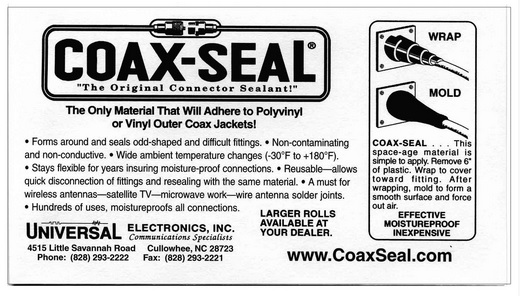 CoaxSeal.com makes
a fine reusable product that remains soft and pliable. It is easily
removed
and rarely leaves any residue. However, if the splice can be stepped on
or is in a traffic or climbing area, the sealant can be disturbed
or scrapped off, thereby exposing the connector to weather. I would
suggest placing a wrap of Scotch 33 vinyl tape over the CoaxSeal, for
protection from scrapes or dislodging. A typical roll is 1/2 inch
wide and 60" [5 ft]
long. A roll costs around $6 and is widely available at master distributors or on the Internet. Coax-Seal is
easily wrapped and then molded by hand to your desired finish.
CoaxSeal.com makes
a fine reusable product that remains soft and pliable. It is easily
removed
and rarely leaves any residue. However, if the splice can be stepped on
or is in a traffic or climbing area, the sealant can be disturbed
or scrapped off, thereby exposing the connector to weather. I would
suggest placing a wrap of Scotch 33 vinyl tape over the CoaxSeal, for
protection from scrapes or dislodging. A typical roll is 1/2 inch
wide and 60" [5 ft]
long. A roll costs around $6 and is widely available at master distributors or on the Internet. Coax-Seal is
easily wrapped and then molded by hand to your desired finish.
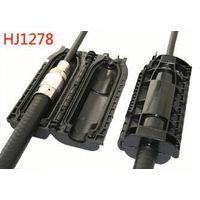 There
may be other practical methods to moisture proof and thermally insulate
the connectors, but these above are the best we have seen. For example,
there are snap-on covers that provide thermal protection, but are not
always waterproof, even filled with silicone gel, as shown to the left.
[and what a mess when you open to perform service]
There
may be other practical methods to moisture proof and thermally insulate
the connectors, but these above are the best we have seen. For example,
there are snap-on covers that provide thermal protection, but are not
always waterproof, even filled with silicone gel, as shown to the left.
[and what a mess when you open to perform service]
As
with all products, some are better than others. It all depends upon on
how important it is doing the job right the first time, and
adopting a procedure for your crew, so even a not-so-bright employee,
cannot do it wrong.
Revised May 19, 2018 by Fred Daniel
 Packing
with silicon gel or grease - This concept we learned from the Air Force. It
seems that whenever an airplane takes off & reaches altitude, and then
eventually lands, the temperature of some of the electrical &
electronics equipment [outside the passenger area] can vary more than 50
degrees F, and sometimes over 100 degrees. This thermal shock with moist outside air cause small amounts of
condensation in electrical connectors, which leads to erratic performance of fire control RADAR
and other Radio equipment. It had long been standard practice to fill
the AN style electrical connectors with silicone grease, to prevent
arcing between pins from moisture. So it also became a standard practice to pack the inside of all
type-N coax connectors with silicone gel. It has been my experience
this works very well, but is very messy to work with, in particular
at the top of a tower. Andrew
has long supplied a tiny unmarked tube of this with each Heliax
connector to weatherproof the inside of the front and rear of each
connector. If the silicon grease gets on the outside of
the cable or connectors, due to mis-handling, vinyl tape will not stick.
However, if you are assembling things on the ground, and you have
clean rags and solvent to cleanup with, go for it. This product is sold as Dow Corning 4 Electrical Insulating Compound and is widely available from $12 to $18 per 5.3 Oz. tube. I buy from Skygeek.com
for under $15 per tube. One tube will last for many years if used just
for coax connectors. You may also find new military surplus tubes that
are out-of-date, but will work just fine. Be sure to wrap the outside of
the connectors with at least two layers of Scotch 33 [and 2242] tape when complete. Be advised, this is not
the same product as silicon sealant, this is a gel that remains a gel
and does not become solid. Do not use silicone sealant inside a
connector.
Packing
with silicon gel or grease - This concept we learned from the Air Force. It
seems that whenever an airplane takes off & reaches altitude, and then
eventually lands, the temperature of some of the electrical &
electronics equipment [outside the passenger area] can vary more than 50
degrees F, and sometimes over 100 degrees. This thermal shock with moist outside air cause small amounts of
condensation in electrical connectors, which leads to erratic performance of fire control RADAR
and other Radio equipment. It had long been standard practice to fill
the AN style electrical connectors with silicone grease, to prevent
arcing between pins from moisture. So it also became a standard practice to pack the inside of all
type-N coax connectors with silicone gel. It has been my experience
this works very well, but is very messy to work with, in particular
at the top of a tower. Andrew
has long supplied a tiny unmarked tube of this with each Heliax
connector to weatherproof the inside of the front and rear of each
connector. If the silicon grease gets on the outside of
the cable or connectors, due to mis-handling, vinyl tape will not stick.
However, if you are assembling things on the ground, and you have
clean rags and solvent to cleanup with, go for it. This product is sold as Dow Corning 4 Electrical Insulating Compound and is widely available from $12 to $18 per 5.3 Oz. tube. I buy from Skygeek.com
for under $15 per tube. One tube will last for many years if used just
for coax connectors. You may also find new military surplus tubes that
are out-of-date, but will work just fine. Be sure to wrap the outside of
the connectors with at least two layers of Scotch 33 [and 2242] tape when complete. Be advised, this is not
the same product as silicon sealant, this is a gel that remains a gel
and does not become solid. Do not use silicone sealant inside a
connector.
 Glue
filled heat-shrink tubing
Glue
filled heat-shrink tubing Wrap
with real rubber tape
Wrap
with real rubber tape  -
layer 1 is a thin vinyl tape which should be 15% overwrap and is to
protect the finish of the connectors, use
-
layer 1 is a thin vinyl tape which should be 15% overwrap and is to
protect the finish of the connectors, use 
 There
may be other practical methods to moisture proof and thermally insulate
the connectors, but these above are the best we have seen. For example,
there are snap-on covers that provide thermal protection, but are not
always waterproof, even filled with silicone gel, as shown to the left.
[and what a mess when you open to perform service]
There
may be other practical methods to moisture proof and thermally insulate
the connectors, but these above are the best we have seen. For example,
there are snap-on covers that provide thermal protection, but are not
always waterproof, even filled with silicone gel, as shown to the left.
[and what a mess when you open to perform service]